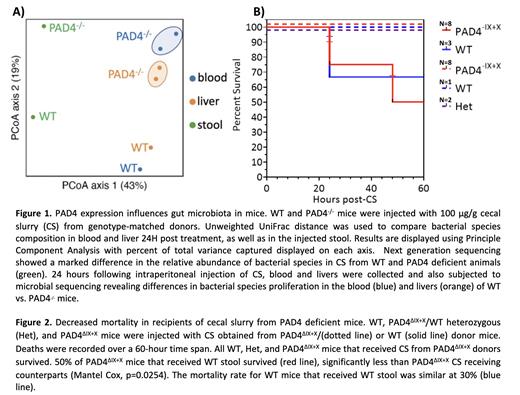Introduction: As part of the innate immune response, neutrophils release neutrophil extracellular traps (NETs), webs of decondensed chromatin coated with histones that capture bacteria but cause collateral tissue damage when produced in a dysregulated manner. Deficiency of PAD4, a protein that converts histone arginine to citrulline to promote chromatin decondensation essential to NET release (NETosis), has been associated with improved outcomes in murine sepsis models, leading some to propose that inhibiting NETosis may be protective. This conclusion has primarily been drawn from studies using the murine cecal-ligation and puncture (CLP) model of polymicrobial sepsis, in which the cecum is perforated to disseminate GI microbiota. However, NET release is an evolutionarily conserved function, present in protozoa and retained in all studied animal species, suggesting that it plays a crucial role in the immune response. In this study, we seek to characterize the baseline immunophenotype of NET-deficient, PAD4 knockout (PAD4 -/-) mice, to determine how PAD4 influences the GI microbiome to impact outcomes in GI models of polymicrobial sepsis.
Methods: Whole blood samples were collected from wild type (WT) C57BL/6 mice, PAD4 -/- mice generated by our group through deletion of exon II in the PAD4 gene (PAD4D ΔII), and PAD4 -/- mice with deletion of exon IX and X (PAD4D ΔIX+X) obtained from Jackson laboratory. Complete blood counts (CBCs) and weights were obtained from PAD4 -/- and healthy WT mice at 9-12 weeks. The Olink target 96 mouse exploratory panel was used to quantify variation in levels of 96 plasma proteins. Next generation sequencing was used to assess the abundance of different bacterial species in stool samples from WT, PAD4D ΔII, and PAD4D ΔIX+X animals. Polymicrobial sepsis was then induced through peritoneal injections of cecal slurry (CS), using cecal samples from WT, PAD4D ΔII, and PAD4D ΔIX+X donor mice. 24 hours post injection, mean sepsis score (MSS) was assessed, and blood was obtained for CBC measurement, plasma proteomic analysis, and quantification of bacterial colony forming units (CFUs). Relative abundance of bacterial species was quantified in blood and liver homogenates. Survival outcome was performed on parallel subsets of WT and PAD4 -/- mice.
Results: At comparable ages, both strains of PAD4 -/- animals had lower weights and significantly higher baseline neutrophil counts than WT controls bred in the same colony. Proteomic analysis revealed that PAD4D ΔII mice had baseline elevation in the inflammatory markers IL6 and Plin1, while PAD4D ΔIX+X mice, the strain with more pronounced neutrophilia, had higher GM-CSF and decreased IL23r, proteins crucial to neutrophil mobilization. In CS sepsis studies, WT animals that received WT CS were sicker with higher MSS, lower platelet counts, higher inflammatory markers, and a 30% mortality rate. In contrast, PAD4D ΔII mice that received PAD4D ΔII CS had a milder clinical course, lower bacterial dissemination, and 100% survival (Fig2). To assess the basis for this unexpected outcome, we compared bacterial colony-forming units (CFU) in WT to PAD4 -/- CS and found lower levels of bacteria in PAD4D ΔII CS. Deep sequencing of stool from WT, PAD4D ΔII, and PAD4D ΔIX+X animals revealed marked differences in the relative abundance of bacterial species. Sequencing of blood and liver samples obtained 24 hrs after CS injection showed that the predominant proliferating organism in WT mice was Enterococcaceae species while there was an abundance of Lactobacillaceae species in the blood and liver of PAD4D ΔII mice (Fig1). Sepsis studies repeated with genotype switched CS showed that WT mice treated with PAD4D ΔIX+X CS had a milder disease course with 100% survival, whereas PAD4D ΔIX+X mice injected with WT CS had elevated MSS, a trend towards higher plasma inflammatory markers, and a 50% mortality rate, similar to that observed in WT mice injected with WT CS (Fig2).
Conclusions: These studies show that NETosis influences baseline inflammation and modulates the GI microbiome in mice. Differences in disease severity and survival between PAD4 -/- and WT mice observed in the CS model of polymicrobial sepsis is primarily due to greater pathogenicity of the WT CS inoculum rather than collateral tissue damage secondary to dysregulated NETosis. The basis for differences in inflammation and microbiome composition in PAD4 -/- mice needs to be examined.
Disclosures
Poncz:Astra Zeneca: Research Funding.


This feature is available to Subscribers Only
Sign In or Create an Account Close Modal